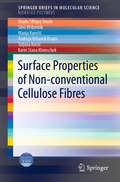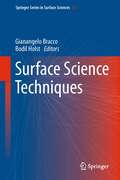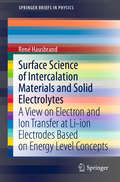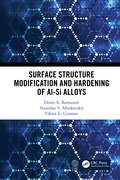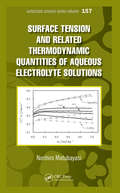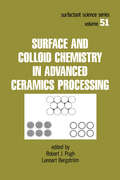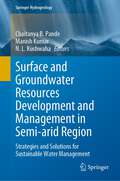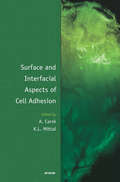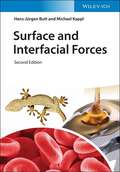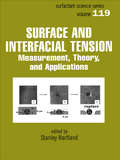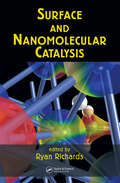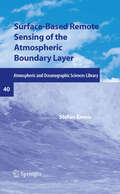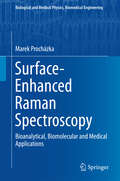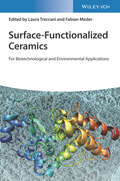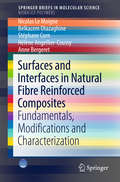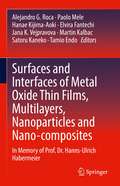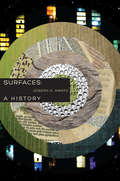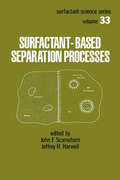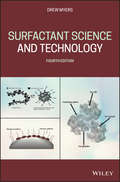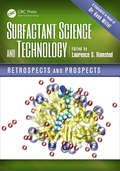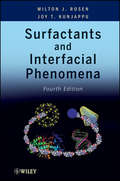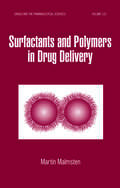- Table View
- List View
Surface Properties of Non-conventional Cellulose Fibres (SpringerBriefs in Molecular Science)
by Manja Kurečič Karin Stana Kleinschek Majda Sfiligoj Smole Silvo Hribernik Andreja Urbanek Krajnc Tatjana KrežeThe authors describe how sustainable textile fibers from crops such as quinoa, grass, hops, corn and wheat stems, etc. have recently begun to generate great interest. The structure-property relationships of such non-conventional cellulose fibers are studied in this brief, as are their sorption and surface properties which are of primary importance. A systematic review of each fiber's properties is given, the emphasis is placed on the water sorption capacity, the fiber's surface potential, and fibrillation properties.
Surface Science Techniques
by Bodil Holst Gianangelo BraccoThe book describes the experimental techniques employed to study surfaces and interfaces. The emphasis is on the experimental method. Therefore all chapters start with an introduction of the scientific problem, the theory necessary to understand how the technique works and how to understand the results. Descriptions of real experimental setups, experimental results at different systems are given to show both the strength and the limits of the technique. In a final part the new developments and possible extensions of the techniques are presented. The included techniques provide microscopic as well as macroscopic information. They cover most of the techniques used in surface science.
Surface Science of Intercalation Materials and Solid Electrolytes: A View on Electron and Ion Transfer at Li-ion Electrodes Based on Energy Level Concepts (SpringerBriefs in Physics)
by René HausbrandThis book shares essential insights into the formation and properties of ionic interfaces based on the energy level structures of their interfaces obtained using a surface science approach. It covers both interfaces with liquid and solid electrolyte contacts, and includes different material classes, such as oxides and phosphates. The specific material properties result in particular effects observed at interfaces, which are often not yet, or not sufficiently, taken into account in battery development and technologies.Discussing fundamental issues concerning the properties of intercalation electrodes and electrode–solid electrolyte interfaces, the book investigates the factors that determine voltage, kinetics and reactivity. It presents experimental results on interface formation, and relates them to electron and ion energy levels in the materials and at their interfaces. It explores these topics integrating electrochemistry, solid-state ionics and semiconductor physics, and accordingly will appeal not only to battery scientists, but also to a broader scientific community, including material scientists and electrochemists.
Surface Structure Modification and Hardening of Al-Si Alloys
by Denis A. Romanov Stanislav. V. Moskovskii Viktor E. GromovSurface Structure Modification and Hardening of Al-SI Alloys explores the hardening of material surfaces using concentrated energy flows resulting in the nanostructuring of surface layers. The authors demonstrate how these methods achieve a reduction in plastic deformation of the surface and a more uniform distribution of elastic stresses near the surface during operational use, significantly reducing part failure. It presents results from research and scientific and technological enterprises involved with the modification of light alloy surfaces for use in the automobile and aerospace industries. Additional key features include: Addresses theoretical and experimental research computer simulations of structural phase transformations at the nanolevel to create new materials Details and compares electroexplosion alloying, electron beam processing and electron-plasma alloying of an Al-Si Alloy Explains multiphase plasma jet treatment to obtain high-quality coatings with good and high functional properties This reference is a valuable resource for specialists in the field of physical material science, condensed state physics, metal science and thermal treatment and will be of interest to undergraduate and post-graduate students in these fields.
Surface Tension and Related Thermodynamic Quantities of Aqueous Electrolyte Solutions
by Norihiro MatubayasiSurface tension provides a thermodynamic avenue for analyzing systems in equilibrium and formulating phenomenological explanations for the behavior of constituent molecules in the surface region. While there are extensive experimental observations and established ideas regarding desorption of ions from the surfaces of aqueous salt solutions, a more
Surface Tension in Microsystems: Engineering Below the Capillary Length
by Pierre LambertThis book describes how surface tension effects can be used by engineers to provide mechanical functions in miniaturized products (<1 mm). Even if precursors of this field such as Jurin or Laplace already date back to the 18th century, describing surface tension effects from a mechanical perspective is very recent. The originality of this book is to consider the effects of capillary bridges on solids, including forces and torques exerted both statically and dynamically by the liquid along the 6 degrees-of-freedom. It provides a comprehensive approach to various applications, such as capillary adhesion (axial force), centering force in packaging and micro-assembly (lateral force) and recent developments such as a capillary motor (torque). It devises how surface tension can be used to provide mechanical functions such as actuation (bubble-actuated compliant table), sealing and tightness, energy harvesting, nanodispending.
Surface and Colloid Chemistry in Advanced Ceramics Processing (Surfactant Science Ser. #51)
by Robert J. Pugh Lennart BergströmEmphasizes the importance of surface and colloid chemistry in the manufacture of high-performance ceramics. Examines processing-property relationships, powderproductionandcharacte6zation,the dispersion properties of powders in liquids, the rheology of concentrated suspensions, and the surface and colloid chemistry aspects of the most widely used forming methods.
Surface and Groundwater Resources Development and Management in Semi-arid Region: Strategies and Solutions for Sustainable Water Management (Springer Hydrogeology)
by Manish Kumar Chaitanya B. Pande N. L. KushwahaThis book explains the challenges for efficient sustainable surface and groundwater development and management with the focus on India and other countries, providing a stable output presentation by using machine learning data mining methods, and modeling. It is a combination of machine learning, modeling, google earth engine, climate data modeling, remote sensing and GIS techniques, surface water modeling, AHP modeling, groundwater quality analysis, aquifer mapping, land use and land cover analysis, forecasting of water and rainfall and so on, its use to sustainable development, planning, and management of groundwater purposes in India and other countries. The main purpose of this book will develop better outlines for the development of surface and groundwater and management in the semi-arid region climate, which supports the Sustainable Development Goals (SDGs) in India, especially on sustainable surface water and groundwater resources management. This book provides a multidisciplinary overview for the faculty members, administrators scientists, policymakers, social science, and professionals involved in the various aspects of sustainable groundwater development, planning, and management.
Surface and Interfacial Aspects of Cell Adhesion
by K. L. Mittal A. CarréCell adhesion comes into play in almost all domains of life. The range of situations in which it occurs, involving organisms, living tissues, microorganisms or single cells, is endless. Cell adhesion is involved in the binding of a cell to a surface, extracellular matrix, or another cell using cell adhesion molecules. It is crucial in the formation
Surface and Interfacial Forces
by Hans-Jürgen Butt Michael KapplA general introduction to surface and interfacial forces, perfectly combining theoretical concepts, experimental techniques and practical applications. In this completely updated edition all the chapters have been thoroughly revised and extended to cover new developments and approaches with around 15% new content. A large part of the book is devoted to surface forces between solid surfaces in liquid media, and while a basic knowledge of colloid and interface science is helpful, it is not essential since all important concepts are explained and the theoretical concepts can be understood with an intermediate knowledge of mathematics. A number of exercises with solutions and the end-of-chapter summaries of the most important equations, facts and phenomena serve as additional tools to strengthen the acquired knowledge and allow for self-study. The result is a readily accessible text that helps to foster an understanding of the intricacies of this highly relevant topic.
Surface and Interfacial Tension: Measurement, Theory, and Applications (Surfactant Science Ser. #Vol. 119)
by Stanley HartlandThis edited volume offers complete coverage of the latest theoretical, experimental, and computer-based data as summarized by leading international researchers. It promotes full understanding of the physical phenomena and mechanisms at work in surface and interfacial tensions and gradients, their direct impact on interface shape and movement, and t
Surface and Nanomolecular Catalysis
by Ryan RichardsUsing new instrumentation and experimental techniques that allow scientists to observe chemical reactions and molecular properties at the nanoscale, the authors of Surface and Nanomolecular Catalysis reveal new insights into the surface chemistry of catalysts and the reaction mechanisms that actually occur at a molecular level during catalys
Surface and Tip-Enhanced Raman Scattering Spectroscopy: Bridging Theory and Applications
by Yukihiro Ozaki Marek Procházka Janina Kneipp Bing ZhaoThis book describes recent progress in the mechanistic studies and applications of surface-enhanced Raman scattering (SERS) and tip-enhanced Raman scattering (TERS). In this book, various novel techniques in SERS and TERS such as UV resonance TERS, electrochemical TERS, and three-dimensional SERS imaging are outlined. A number of new applications of SERS and TERS such as those to photonics, nanotechnology, microfluidics, and medical diagnosis along with future perspectives are also discussed. Finally, the applications of new data analysis, models, and machine learning in SERS and TERS studies are reviewed. The novelty of this book is the forming of a new bridge between the theory and applications. Also, the importance of chemical mechanism and that of semiconductor-enhanced Raman scattering is emphasized. The main audiences are researchers in academia, research institutes, companies, and graduate students looking for a comprehensive book on the latest studies of SERS and TERS.
Surface-Based Remote Sensing of the Atmospheric Boundary Layer
by Stefan EmeisThe book presents a comprehensive overview of the current state-of-the-art in the atmospheric boundary layer (ABL) research. It focuses on experimental ABL research, while most of the books on ABL discuss it from a theoretical or fluid dynamics point of view. Experimental ABL research has been made so far by surface-based in-situ experimentation (tower measurements up to a few hundred meters, surface energy balance measurements, short aircraft experiments, short experiments with tethered balloons, constant-level balloons, evaluation of radiosonde data). Surface flux measurements are also discussed in the book. Although the surface fluxes are one of the main driving factors for the daily variation of the ABL, an ABL description is only complete if its vertical structure is analyzed and determined. Satellite information is available covering large areas, but it has only limited temporal resolution and lacks sufficient vertical resolution. Therefore, surface-based remote sensing is a large challenge to enlarge the database for ABL studies, as it offers nearly continuous and vertically highly resolved information for specific sites of interest. Considerable progress has been made in the recent years in studying of ground-based remote sensing of the ABL. The book discusses such new subjects as micro-rain radars and the use of ceilometers for ABL profiling, modern small wind lidars for wind energy applications, ABL flux profile measurements, RASS techniques, and mixing-layer height determination.
Surface-Enhanced Raman Spectroscopy
by Marek ProcházkaThis book gives an overview of recent developments in RS and SERS for sensing and biosensing considering also limitations, possibilities and prospects of this technique. Raman scattering (RS) is a widely used vibrational technique providing highly specific molecular spectral patterns. A severe limitation for the application of this spectroscopic technique lies in the low cross section of RS. Surface-enhanced Raman scattering (SERS) spectroscopy overcomes this problem by 6-11 orders of magnitude enhancement compared with the standard RS for molecules in the close vicinity of certain rough metal surfaces. Thus, SERS combines molecular fingerprint specificity with potential single-molecule sensitivity. Due to the recent development of new SERS-active substrates, labeling and derivatization chemistry as well as new instrumentations, SERS became a very promising tool for many varied applications, including bioanalytical studies and sensing. Both intrinsic and extrinsic SERS biosensing schemes have been employed to detect and identify small molecules, nucleic acids and proteins, and also for cellular and in vivo sensing.
Surface-Functionalized Ceramics: For Biotechnological and Environmental Applications
by Laura Treccani Fabian MederSurface-Functionalized Ceramics Focused coverage of making and using functional ceramic materials for a wide variety of scientific and technical applications Surface-Functionalized Ceramics provides a comprehensive overview of surface functionalization approaches for ceramic materials, including alumina, zirconia, titania, and silica, and their uses as sensors, chemical, and biological probes, chromatographic supports for (bio)molecule purification and analysis, and adsorbents for toxic substances and pollutants. Overall, the text provides a broad picture of the enormous possibilities offered by surface functionalization and addresses the current challenges regarding surface analysis, characterization, and stability. As a well-rounded resource, the text points out opportunities of surface-functionalized ceramics, their issues such as achieving surface stability and complex analysis, and how to counter them. Edited by two experts in the field of advanced materials surfaces, Surface-Functionalized Ceramics covers topics such as: Processing methods for advanced ceramics, surface modification of ceramic materials, and methods for electrokinetic surface characteristics Surface imaging and chemical surface analysis using atomic force microscopy Surface chemical analysis and ceramic-enhanced analytics Biological and living matter-surface interactions including protein adsorption mechanisms as well as bacteria behavior in terms of biofilm formation and prevention for antibacterial applications Mesoporous silica and organosilica biosensors for water quality and environmental monitoring, plus ceramic-based adsorbents in bioproduct recovery and purification For professionals, researchers, and academics in the fields of materials science, biotechnology, biotechnological industry, environmental sciences, and ceramics industry, Surface-Functionalized Ceramics is a one-stop reference on the subject that provides different approaches to obtain surfaces of ceramic materials that perform desired functions.
Surface/Volume: How Geometry Explains Why Grain Elevators Explode, Hummingbirds Hover, and Asteroids are Colder than Ice
by Alan E. RubinThis book explains that diffusion, osmosis, dissolution, evaporation, and heat loss all preferentially affect small bodies due to their high surface/volume ratios. Because surface area increases as the square of length, but volume (and mass) increase as the cube, large objects have low surface/volume ratios and small objects have high surface/volume ratios. This simple physical constraint governs much of the physical world. It accounts for why the Earth has active volcanoes, but the Moon does not, why the human brain has numerous folds, why deciduous trees lose their leaves every Fall, and why nanoparticles of gold melt at surprisingly low temperatures. It is a phenomenon well known to every scientist, but this book is the first comprehensive treatment of this effect.
Surfaces and Interfaces in Natural Fibre Reinforced Composites
by Nicolas Le Moigne Belkacem Otazaghine Stéphane Corn Hélène Angellier-Coussy Anne BergeretThis book is addressed to Master and PhD students as well as researchers from academia and industry. It aims to provide the key definitions to understand the issues related to interface modifications in natural fibre based composites considering the particular supramolecular and micro- structures encountered in plant fibres. A particular emphasis is given to the modification and functionalization strategies of natural fibres and their impact on biocomposites behaviour and properties. Commonly used and newly developed treatment processes are described in view of scaling-up natural fibre treatments for their implementation in industry. Finally, a detailed and comprehensive description of the tools and methodologies developed to investigate and characterize surfaces and interfaces in natural fibre based composites is reviewed and discussed.
Surfaces and Interfaces of Metal Oxide Thin Films, Multilayers, Nanoparticles and Nano-composites: In Memory of Prof. Dr. Hanns-Ulrich Habermeier
by Paolo Mele Tamio Endo Satoru Kaneko Alejandro G. Roca Hanae Kijima-Aoki Elvira Fantechi Jana K. Vejpravova Martin KalbacThis book provides a general overview and current state of the art of different types of metal oxide nanomaterials, either in nanoparticles or thin film structure. It covers from the development and optimization of different nanofabrication/synthesis techniques for nanostructures which are currently the attention of the research community, the study of the structure and interactions by different characterization techniques of heterostructured materials and the final impact in different applications such as nanotherapy, data storage, super magnets, high-frequency devices. The book’s 13 chapters provide deep insight into the intriguing science of oxide materials and include contributions on novel technologies to fabricate nanomaterials with a broad range of functional properties (semiconducting, magnetic, ferroelectric, thermoelectric, optical, flexible and mechanical). This book is intended to the experts for consolidation of their knowledge but also for students who aim to learn and get basics of nanostructured metal oxides in diverse forms.
Surfaces: A History
by Joseph A. AmatoHuman beings are surrounded by surfaces: from our skin to faces, to the walls and streets of our homes and cities, to the images, books, and screens of our cultures and civilizations, to the natural world and what we imagine beyond. In this thought-provoking and richly textured book, Joseph A. Amato traces the human relationship with surfaces from the deep history of human evolution, which unfolded across millennia, up to the contemporary world. Fusing his work on Dust and On Foot, he shows how, in the last two centuries, our understanding, creation, control, and manipulation of surfaces has become truly revolutionary--in both scale and volume. With the sweep of grand history matched to existential concerns for the present, he suggests that we have become the surfaces we have made, mastered, and now control, invent, design, and encapsulate our lives. This deeply informed and original narrative, which joins history and anthropology and suggests new routes for epistemology and aesthetics, argues that surfaces are far more than superficial façades of deep inner worlds.
Surfactant - Based Separation Processes
by John F. ScamehornFocuses on novel techniques and reviews established methods for surfactant-based separation processes that can be widely applied in industry. Describes new extraction techniques, micellar-enhanced ultrafiltration and admicellar chromatography, protein extraction using reverse micelles, surfactant-en
Surfactant Science and Technology
by Drew MyersA solid introduction to the field of surfactant science, this new edition provides updated information about surfactant uses, structures, and preparation, as well as seven new chapters expanding on technology applications. Offers a comprehensive introduction and reference of the science and technology of surface active materials Elaborates, more fully than prior editions, aspects of surfactant crystal structure as well as their effects on applications Adds more information on new classes and applications of natural surfactants in light of environmental consequences of surfactant use
Surfactant Science and Technology: Retrospects and Prospects
by Laurence S. RomstedSurfactant research explores the forces responsible for surfactant assembly and the critical industrial, medical, and personal applications, including viscosity control, microelectronics, drug stabilization, drug delivery, cosmetics, enhanced oil recovery, and foods. Surfactant Science and Technology: Retrospects and Prospects, "a Festschrift in ho
Surfactants and Interfacial Phenomena
by Milton J. Rosen Joy T. KunjappuNow in its fourth edition, Surfactants and Interfacial Phenomena explains why and how surfactants operate in interfacial processes (such as foaming, wetting, emulsion formation and detergency), and shows the correlations between a surfactant's chemical structure and its action. Updated and revised to include more modern information, along with additional three chapters on Surfactants in Biology and Biotechnology, Nanotechnology and Surfactants, and Molecular Modeling with Surfactant Systems, this is the premier text on the properties and applications of surfactants. This book provides an easy-to-read, user-friendly resource for industrial chemists and a text for classroom use, and is an unparalleled tool for understanding and applying the latest information on surfactants. Problems are included at the end of each chapter to enhance the reader's understanding, along with many tables of data that are not compiled elsewhere. Only the minimum mathematics is used in the explanation of topics to make it easy-to-understand and very user friendly.
Surfactants and Polymers in Drug Delivery (Drugs and the Pharmaceutical Sciences)
by Martin MalmstenThis reference features the latest findings surrounding the physicochemical aspects of surfactant and polymer systems to facilitate the design and understanding of novel and advanced drug delivery formulations. It covers the basics of surfactant and polymer surface activity and self-assembly, the various types of structures formed by such compounds
